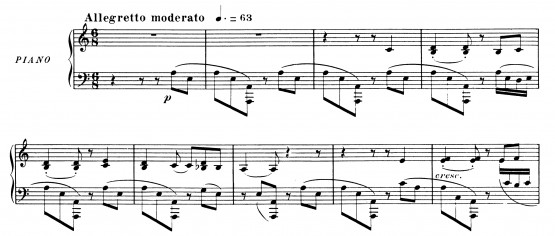During a presentation by James Parakilas concerning examples of ambiguous musical notation, I noticed something. Parakilas was discussing the metrical organization in Fauré’s tenth barcarolle. A curious hovering syncopation pervades the music.
Fauré: Tenth Barcarolle
A detail of piano writing in measure 7 corresponds, in my opinion, to the practice of singing an audible final syllable for a French word like “rose.” Normally spoken as one syllable — in poetry or singing, this word may become: “ro-se.”
In the barcarolle, a final syllable is made for the long note (A4) that concludes the phrase in m. 7. This “final syllable” happens because the melody note is held while low bass As (A2 and A3) are played. The playing of the low notes makes an audible swell in the higher held-pitch, it’s an overtone. The stimulation of that overtone is represented by the notation. There’s a final eighth-note tied to the quarter-note. (Elsewhere dotted-quarter-notes are written.)
Sung French includes such shifting of emphasis toward final syllables unheard in the spoken language. A shift that fits well into the emphasis-world of the tenth barcarolle.
Barcarol-le.

